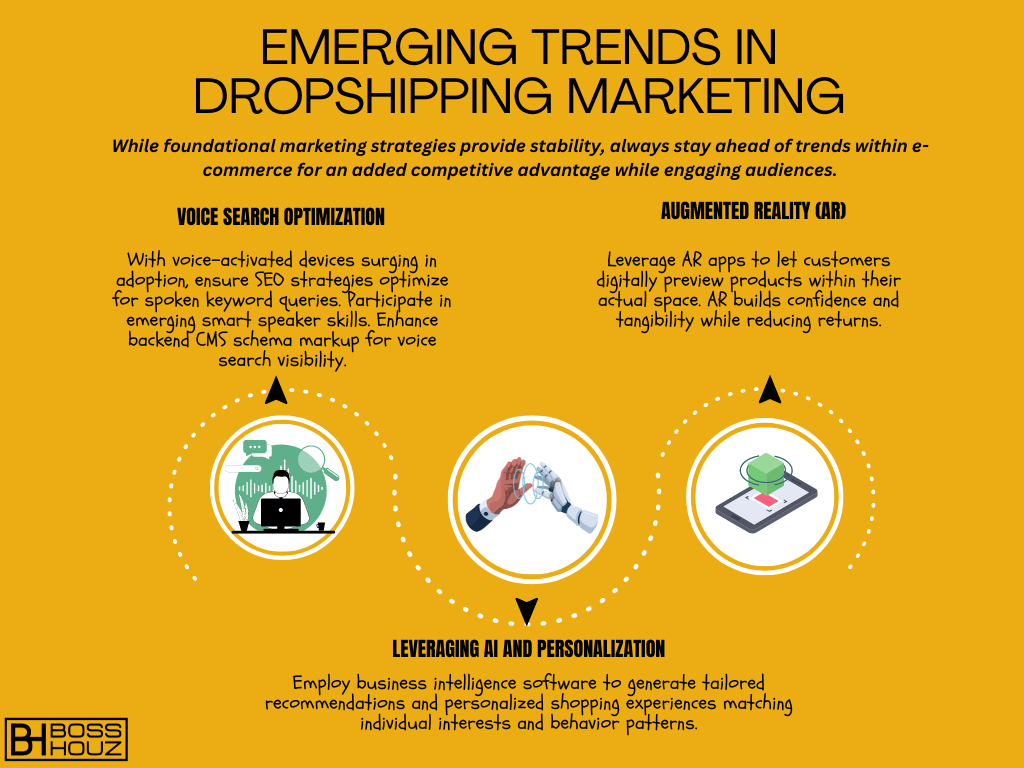Dropshipping has exploded in popularity as an e-commerce model that lets entrepreneurs start an online business without huge upfront costs or inventory requirements.
However, successfully running a dropshipping store entails much more than just setting up a Shopify storefront and connecting it to a supplier.
In our highly competitive online marketplace, implementing the right marketing strategies is crucial for standing out, attracting customers, and ultimately driving sales.
Table of Contents
Understanding Your Dropshipping Niche and Target Audience

Defining and researching your niche market provides the entire foundation for marketing success. Before burning advertising dollars or creating content, you must intimately understand buyer needs, pain points, and interests within your specific industry.
Identifying Your Niche
Pinpoint 2-3 narrow, specialized niches for your dropshipping catalog by researching:
- Market size, growth trends, and overall demand
- Competition levels from both dropshippers and traditional retailers
- Average pricing thresholds and price sensitivity
- General demographic and psychographic characteristics
Online tools like Google Trends, SEMrush, and Facebook’s Audience Insights can quantify search volumes and buyer behavior. But also dive deeper by examining forums, social media groups, reviews sites, and niche influencers. Gather insights directly from potential customers.
By selecting less saturated, high-demand niches, you position yourself advantageously versus rivals while targeting consumers actively looking for related products.
Defining Your Target Audience
Once you’ve selected specific niches, define your target audience parameters including:
- Demographic details like age, income, location
- Psychographic qualities such as values, interests, personality attributes
- Shopping preferences and purchasing motivations
- Frequency of purchases within your product categories
Online survey tools like Typeform and Google Forms can collect customer data directly. Additionally, leverage Facebook’s detailed audience segmentation for transparent stats.
By understanding the distinct wants and needs of your ideal buyers, you enable crafting highly tailored marketing campaigns that resonate.
Developing Your Dropshipping Brand
Cultivating a memorable, trustworthy brand provides the foundation for long-term customer relationships driving repeat purchases and referrals.
Importance of Branding in E-commerce
In the digital marketplace, consumers increasingly buy based on brand affinity over pure product details. A 2017 survey found 68% will only purchase from brands they personally know and trust.
Brand identity encapsulates inward elements like your core values, personality, vision and internal culture. Brand image represents external perceptions from customers. Aligning both is key.
Building a Unique Brand for Your Dropshipping Store
Stand out by infusing creativity into your branding, including:
- A catchy, easy-to-remember business name utilizing memorable words, alliteration or rhyme
- A sleek yet meaningful logo integrating visuals that communicate your niche
- Defined brand voice, messaging and style guidelines for marketing assets to follow
From branded packaging to consistent site navigation and custom graphics, ensure cohesion across touchpoints.
Define your “why” and core differentiators while also promoting benefits customers care about — high-quality imports, 5-star customer service, sustainability initiatives, charitable partnerships or more. Consistent, thoughtful branding builds familiarity turning one-time buyers into lifelong brand advocates.
Optimizing Your Dropshipping Store for Conversions
With a strategic brand and ideal audience defined, fine-tune your Shopify store’s design and functionality to remove friction from the buyer journey. Subtle UX and conversion rate optimization elevate sales.
Website Design and User Experience (UX)
Streamline navigation with clear IA (information architecture), smart menus and simple product organization informed by search data. Ensure fast load speeds and seamless mobile responsiveness meeting Google’s mobile-first indexing requirements.
Showcase products beautifully with high-quality images, crisp descriptions and lifestyle visual content. Video demos and 360-degree views build deeper product understanding. Simplify product finding through filters and faceted navigation.
Craft product detail pages to address buyer questions and objections. Emphasize unique selling points over generic descriptions using conversational language.
Enhancing the Checkout Process
Optimize final purchase steps removing unnecessary fields to reduce abandonment. Allow guest checkouts. Offer multiple payment methods like PayPal. Provide reassurance through trust badges, security seals and money-back guarantees.
Overall, crafting intuitive, esthetically-pleasing storefronts with an excellent user experience drives higher conversions.
Leveraging SEO for Organic Traffic
SEO remains vital for dropshipping e-commerce stores to drive qualified organic traffic through search engines cost-effectively. Robust technical and content optimizations inform Google’s rankings.
On-Page SEO Techniques
Conduct keyword research to identify relevant long-tail phrases buyers are searching. Strategically incorporate keywords within title tags, meta descriptions, content, alt text, schema markup and URL structures.
Produce monthly blogs and long-form product detail content pages targeting ranking phrases, answering questions and providing expertise. Promote content internally via site links and calls-to-action.
Off-Page SEO Tactics
Build credible external links from industry websites through guest contributions, outreach and influencer partnerships. Participate actively in niche forums and groups to gain mentions.
Leverage social media for shares, embeds and links back to content. Optimize profiles with keywords and publish engaging, sharable updates. Claim and enhance free business listings on directories like Google My Business.
By employing core technical SEO best practices combined with value-driven content creation and promotion, dropshipping e-commerce stores stand to draw significant organic traffic from Google and other search engines.
Harnessing the Power of Content Marketing

Beyond pure conversions, rich content builds brand awareness and loyalty over time through consistent value delivery to niche audiences. An effective content strategy clarifies topics and formats tailored specifically to customer interests.
Content Strategy Development
Audit your niche to inventory competitors, influencers and industry leaders producing high-quality content. Identify popular yet underserved themes and customer questions to address through various formats like:
- Educational blog articles
- “How-to” tutorials and guide videos
- Visually engaging graphics and infographics
- Podcast interviews with industry experts
- Behind-the-scenes company content
Map out themes and publish schedules over 3, 6 and 12-month durations. Promote leadership, experience and community support by repurposing content across platforms.
Content Promotion and Distribution
Amplify content reach by sharing natively through built-in site search, email subscribers and strategic on-site calls-to-action. Promote externally on platforms popular among your niche, including relevant:
- Social media channels through both organic and paid methods
- Industry forums and niche communities
- Quora spaces aligning to your customer’s interests and questions
- Pitch guest articles to mid-tier industry blogs accepting contributions
Track content performance closely using UTMs for optimization. Expand types and subjects resonating best.
By providing truly useful, engaging content rather than pure sales pitches, dropshipping merchants demonstrate expertise while nurturing customer relationships over time. Treat content as the cornerstone, not just support, within your digital marketing strategy.
Mastering Social Media Marketing
With 4.2 billion global users as of 2022, social media provides unparalleled opportunities to directly engage target audiences while humanizing your dropshipping brand. Tailor content across chosen platforms specifically to align with usage behaviors.
Choosing the Right Platforms
Audit multiple networks, joining relevant conversations using Social Insider or Social Searcher tools identifying popular hashtags and influencers discussing your niches. Monitor analytics to determine where current and potential audiences are most active.
While Facebook, Instagram and Pinterest dominate overall, don’t overlook emerging niches on Twitter, TikTok or platforms like Goodreads for book sellers. Establish and grow your brand’s presence across suitable channels.
Engaging with Your Audience
Share content and offer helpful advice rather than constant promotions. Respond to conversations and questions to demonstrate responsiveness and build community, trust and loyalty. Incorporate user-generated content from happy customer stories. Collaborate with micro influencers to expand reach.
The social space offers flexibility to promote products while also strengthening awareness and relationships with niche target markets. Actively listen and participate rather than broadcasting.
Email Marketing for Customer Retention and Sales
Email subscriber lists enable communicating directly with prospects and customers at scale while nurturing long-term brand loyalty driving repeat purchases. Segment contacts based on behaviors and purchase history for personalized lifecycle messaging from cart abandonment reminders to win-back campaigns bringing back once loyal patrons.
Building Your Email List
Encourage subscribers through popup/embedded forms and exit intent popups using Privy or MailMunch. Offer compelling lead magnets like exclusive niche ebooks, coupon codes or contest entries in exchange for emails. Make opt-ins visible throughout while confirming GDPR compliance.
Segmenting and Personalizing Email Campaigns
Tag subscribers based on behaviors like email opens/clicks, on-site actions and purchase data through integrated platforms like Klaviyo. Set up workflows sending cart abandonment sequences, browse based retargeting emails and personalized recommendations showcasing newly added inventory selections tailored to individual interests.
Send timely promotional messaging regarding sales, product launches, seasonal offers and more while integrating dynamic content like first names. Always enable easy unsubscribes while monitoring list health metrics.
Well-executed email marketing generates substantial ROI through building meaningful communication channels keeping customers engaged after initial purchases. Treat your list as an asset.
Utilizing Paid Advertising for Immediate Impact
Balancing longer-term brand building strategies, paid advertising delivers faster exposure and conversions from cold audiences. Leverage multiple platforms utilizing robust targeting parameters. Continually test new creatives and offers while closely monitoring performance.
Overview of Paid Advertising Channels
With detailed targeting options, Google Ads and Microsoft Advertising efficiently reach those actively searching for related products using keywords. Retarget across the web through platforms like Facebook, Instagram and Pinterest, showcasing visually impactful ads to cold traffic.
For new stores without reviews, run paid advertising concurrently with content marketing and organic social media while perfecting funnels for efficiency at scale later on.
Crafting Effective Ad Campaigns
Research competitors and high-performing brands advertising in your space for inspiration. A/B test ad elements like imagery, copy, calls to action and more. Refine targeting parameters based on website analytics conveying engaged segments.
Allocate testing budgets while monitoring conversion metrics diligently, pausing poorly performing ads promptly while doubling down on those resonating. Let data drive decisions.
Paid advertising compliments organic marketing driving immediate visibility and conversions during launch phases or seasonal promotions needing a quick boost for dropshipping stores.
Analyzing and Optimizing Marketing Strategies
With an array of short and long-term strategies in place, rely on hard metrics including Google Analytics to optimize accordingly. Methods like A/B testing evaluate proposed changes. Monitor campaigns, channels and assets for maximum ROI.
Utilizing Analytics for Insights
Connect Google Analytics to track key performance indicators (KPIs) like:
- Overall website traffic volumes
- Top landing/exit pages
- Traffic sources driving conversions
- Keyword and top content rankings
- Email open, clickthrough and unsubscribe rates
- Sales and conversion numbers across funnels
Uncover customer behavior patterns. Identify strengths to expand and problem areas to improve.
Continuous Improvement through A/B Testing
Regularly test isolated changes across elements like email subject lines, content headlines, website pages, checkout processes or more using dedicated tools like Google Optimize or Optimizely.
Let statistical significance determine winning variations based on target metrics like email open rates or landing page conversions. Roll out improvements systematically while documenting learnings.
Carefully monitoring performance and running A/B testing fuels data-backed optimization for maximum marketing ROI. Never remain stagnant.
Emerging Trends in Dropshipping Marketing

While foundational marketing strategies provide stability, always stay ahead of trends within e-commerce for an added competitive advantage while engaging audiences.
Voice Search Optimization
With voice-activated devices surging in adoption, ensure SEO strategies optimize for spoken keyword queries. Participate in emerging smart speaker skills. Enhance backend CMS schema markup for voice search visibility.
Augmented Reality (AR)
Leverage AR apps to let customers digitally preview products within their actual space. AR builds confidence and tangibility while reducing returns.
Leveraging AI and Personalization
Employ business intelligence software to generate tailored recommendations and personalized shopping experiences matching individual interests and behavior patterns.
Frequently Asked Questions About Dropshipping Marketing
What marketing platforms are best for driving new sales?
Depending on budgets and capabilities, effective marketing platforms span SEO, content, email, social media and paid advertising channels like Facebook and Google. Ensure your website seamlessly links all platforms using tags and UTM parameters for performance tracking.
How much should I budget for marketing expenses?
When launching, allocate 15-25% of overall estimated revenue for marketing purposes if aiming for rapid growth. The majority should fund testing paid advertising on social platforms and Google to identify profitable channels before scaling budgets upwards of 50-60% to aggressively gain market share.
What metrics should I track for digital marketing campaigns?
Vital metrics span overall website traffic to specific landing pages, referral channels producing sales, conversion rates across funnels, cost per lead/sale by source, email open/clickthrough rates and more. Connect Google Analytics to all platforms and meticulously track KPIs.
Wrapping Up Top Marketing Strategies for Dropshipping Businesses
Marketing represents an invaluable competitive edge for e-commerce brands to attract customers amid endless options online. Rather than random tactics, develop fully integrated strategies spanning creative brand building to data-backed optimization for efficiency. By genuinely understanding your target buyer’s end-to-end journey, you can identify pain points to solve through customer-centric messaging and seamless shopping experiences.
Stay agile and optimistic, testing new platforms as they emerge while leveraging analytics to double down on what works. Never stop learning about your products, services and most importantly, your customers. Combine creativity with the metrics for sustainable marketing success.








